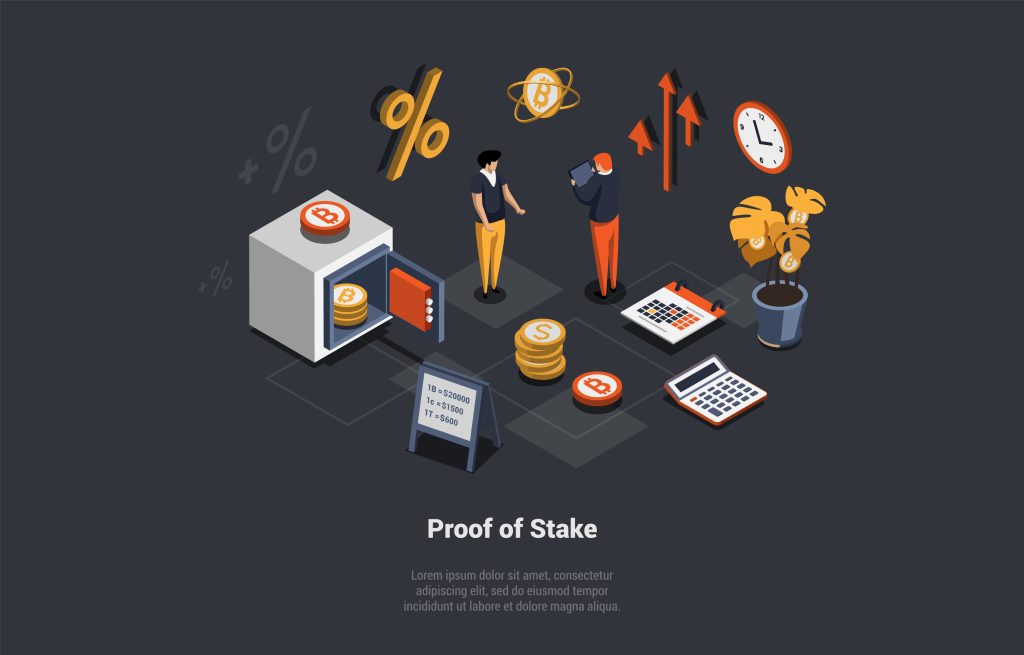Crypto staking strategies can vary depending on the specific cryptocurrency being staked, the individual’s risk tolerance, and investment goals. One typical process is diversifying betting across multiple cryptocurrencies to spread risk and maximize rewards. By staking different coins, investors can take advantage of various staking rewards and potentially benefit from any price appreciation of the staked assets.
Another strategy is to carefully select which cryptocurrencies to stake based on their potential for growth and the staking rewards they offer. Some investors may bet on newer or less well-known cryptocurrencies, offering higher staking tips to achieve more significant returns. However, this approach also comes with increased risk, as newer cryptocurrencies may be more volatile and less established.
Additionally, some investors may opt for a long-term staking strategy, where they stake their coins for an extended period to benefit from compounding rewards and potential price appreciation. This approach requires patience and a long-term outlook, as it may take time for staking rewards to accumulate and for the value of the staked assets to increase. Crypto staking strategies should be carefully considered and aligned with an individual’s investment objectives, risk tolerance, and market conditions.
KEYS TAKEAWAYS
How Do Crypto Staking Work?

Crypto staking allows cryptocurrency holders to participate in the network and validate transactions by staking their coins. This process is typically associated with the Proof-of-Stake (PoS) consensus mechanism, an alternative to the Proof-of-Work (PoW) used in cryptocurrencies like Bitcoin.
When a user stakes their coins, they essentially lock them up in a digital wallet as collateral to support the operations of the blockchain network. In return for staking, users are rewarded with additional coins as a form of interest. The more cash a user stakes, the higher the chance of being chosen to create new blocks and validate transactions, and the greater the rewards they can earn.
Staking helps secure the network and validate transactions, and it also incentivizes users to hold onto their coins rather than sell them. This process is beneficial for the overall stability and security of the blockchain network. Users can stake their coins through dedicated staking platforms and wallets or directly through the cryptocurrency’s network, depending on the specific requirements of each cryptocurrency.
Coin-Specific Staking Guides

Coin-specific staking guides are comprehensive resources designed to assist cryptocurrency holders in understanding and participating in the staking process for a particular digital asset. These guides provide detailed instructions on how to set up a staking wallet, delegate or lock up coins for staking, and begin earning staking rewards. They are tailored to each cryptocurrency’s specific requirements and mechanisms, ensuring users have the information to stake their coins effectively and securely.
In addition to practical instructions, coin-specific staking guides often include information about staking requirements, potential rewards, and the underlying staking protocol used by the cryptocurrency. This information can help users make informed decisions about their staking activities, understand the risks and tips, and optimize their strategies for maximum returns. By providing insights into the technical and operational aspects of staking, these guides empower cryptocurrency holders to actively participate in securing and validating transactions on the blockchain network.
Furthermore, coin-specific staking guides may also cover topics such as the governance structure of the cryptocurrency, the role of stakers in the network consensus, and best practices for maintaining a secure staking setup. These resources are valuable for novice and experienced stakeholders, offering a reliable reference point for understanding the intricacies of stakes and making informed decisions about their activities. Overall, coin-specific staking guides are crucial in promoting broader participation in the ecosystem and fostering a deeper understanding of individual cryptocurrencies’ unique features and requirements.
Staking guides can vary depending on the specific cryptocurrency you’re interested in. Here’s a general outline for a staking guide:
- Understand Staking: Explain what staking is and how it differs from other consensus mechanisms like Proof of Work (PoW).
- Wallet Setup: Guide users on how to set up a wallet that supports staking for the specific cryptocurrency.
- Acquiring Tokens: Explain how to receive the tokens needed for staking. This could involve buying them from an exchange or earning them through other means.
- Transfer to Wallet: Guide users on transferring the tokens to the staking wallet.
- Staking Process: Detail the steps involved in staking, including how to delegate or stake your tokens. Explain the rewards system and how often rewards are distributed.
- Unstaking and Withdrawals: Explain the process of unstaking tokens and withdrawing rewards, if applicable. Highlight any waiting periods or conditions.
- Risks and Considerations: Inform users about the risks associated with staking, such as slashing (penalties for improper behavior in some networks) or potential market risks.
- Troubleshooting: Provide solutions or guidance for common issues users might encounter during the staking process.
- Community and Resources: Offer links to community forums, official documentation, or resources where users can get more information or assistance.
Remember, these steps can significantly differ based on the cryptocurrency and the staking mechanism it uses. Some cryptocurrencies may require a minimum amount of tokens for staking, while others might require specific hardware or software. Always refer to the official documentation or community resources for the most accurate and up-to-date information on staking a particular coin.
What are Staking Pools

Staking pools are collaborative platforms where multiple cryptocurrency holders combine resources to increase their chances of earning staking rewards. In proof-of-stake (PoS) cryptocurrencies, staking pools allow participants to pool their coins together, increasing the likelihood of being selected to approve transactions and receiving staking rewards. This pooling of resources enables users with smaller holdings to participate in staking and receive a proportional share of the tips, which they might have yet to achieve on their own.
Staking pools are typically managed by a central entity that oversees the technical aspects of staking, such as maintaining the necessary infrastructure and validating transactions on behalf of the participants. In return for these services, the staking pool operator may charge a fee, usually a percentage of the staking rewards the participants earn.
Participating in a staking pool can provide several benefits, including a more consistent and predictable stream of staking rewards, reduced technical barriers to staking, and the ability for smaller stakeholders to participate in the staking process. However, it’s essential for participants to carefully evaluate the reputation, fees, performance, and security of staking pools before committing their assets.
Why You Need to Understand Staking Pools

Understanding staking pools is essential for cryptocurrency holders who wish to participate in staking activities. Here are a few reasons why it’s necessary to comprehend staking collections:
- Maximizing Staking Rewards: Staking pools can earn staking rewards by combining resources with other participants. Understanding how staking pools work and comparing options can help individuals maximize their potential rewards.
- Risk Management: By understanding the mechanics of staking pools, individuals can assess the risks associated with participating in a pool, such as the security of the pool, the reputation of the operator, and the potential impact of fees on overall returns. This knowledge can help make informed decisions about where to stake their assets.
- Participation Options: Staking pools allow individuals with smaller holdings to participate in staking, as they can pool their resources with others to increase their chances of earning rewards. Understanding how staking pools function can help individuals with varying levels of cryptocurrency holdings explore their participation options.
- Governance and Operations: Some staking pools offer participants a say in network governance and decision-making processes. Understanding a staking pool’s governance model and operational aspects can help individuals align their staking activities with their values and preferences.
Understanding staking pools is crucial for individuals looking to engage in staking activities. It empowers them to make informed decisions, manage risks, and maximize the potential benefits of participating in staking.
Staking Pool Comparisons

When comparing staking pools, it’s essential to consider several factors to make an informed decision. Here are some key aspects to consider:
- Returns and Fees: Compare the staking rewards offered by different pools and any fees they charge for participation. Some collections may offer higher tips but have higher prices, so evaluating the overall return on investment is essential.
- Reputation and Security: Research each staking pool’s reputation and track record. Look for information on their security measures, uptime, and past incidents. Choose a collection with a strong reputation for reliability and security.
- Size and Performance: Consider the size of the staking pool and its performance. Larger pools may offer more consistent rewards, but smaller pools may provide a more personalized experience. Evaluate the pool’s historical performance and its ability to generate rewards consistently.
- Governance and Transparency: Look for staking pools that offer transparent governance and decision-making processes. Some collections allow participants to have a say in network governance, so understanding the governance model is essential.
- User Experience and Support: Evaluate each staking pool’s user experience and support. A user-friendly interface, clear communication, and responsive support can significantly impact the staking experience.
By carefully comparing these factors, you can make an informed decision when choosing a staking pool that fits the risk and investment objectives you havetolerance. Make sure you do extensive research and consult reliable sources for advice. before participating in any staking collection.
How to Invest in Crypto
Investing in cryptocurrency involves navigating a dynamic and rapidly evolving market that presents opportunities and risks. As with any investment, thorough research and education are essential before entering crypto. Understanding the underlying technology, the different types of cryptocurrencies, and the factors that drive market movements can help investors make informed decisions. Selecting a reputable cryptocurrency exchange and setting up a secure digital wallet are crucial steps in the investment process, ensuring that assets are stored and traded safely and reliably. Diversification, risk management, and staying informed about market trends and regulatory developments are critical considerations for investing in crypto. Keeping an eye on the big picture and getting expert counsel when needed can also contribute to a more strategic and informed approach to cryptocurrency investing.
Investing in crypto requires a cautious and diligent approach due to the market’s inherent volatility and regulatory complexities. It’s essential for investors to assess their risk tolerance carefully and only invest funds they can afford to lose. Keeping abreast of market developments and seeking advice from financial professionals can provide valuable insights for making sound investment decisions. Moreover, staying compliant with relevant regulations and tax laws is crucial as the regulatory landscape for cryptocurrencies continues to evolve. By adopting a well-informed and prudent approach to investing in crypto, individuals can benefit from the opportunities presented by this innovative and rapidly expanding asset class.
Advanced Staking Economics

What is Advanced Staking Economics
Advanced staking economics refers to the complex and sophisticated economic models, strategies, and analyses applied to staking cryptocurrencies within blockchain networks. This field delves into the intricacies of how staking mechanisms, token economics, and network dynamics interact to influence stakeholders’ behavior and the network’s overall health.
Experts in advanced staking economics explore factors such as staking rewards, inflation rates, slashing penalties, validator behavior, and network security. They may also analyze the impact of different staking strategies, governance models, and economic incentives on the stability and decentralization of the network.
Furthermore, advanced staking economics may involve developing and evaluating novel economic models, game theory frameworks, and simulations to understand better the implications of staking activities on the overall functioning and sustainability of blockchain ecosystems.
Overall, advanced staking economics represents a deep and nuanced exploration of the economic principles and dynamics underpinning the staking of cryptocurrencies, focusing on optimizing network security, incentivizing participation, and fostering a robust and sustainable staking environment.
What are the Staking Economics

Staking economics refers to the economic principles, incentives, and mechanisms involved in staking cryptocurrencies within a blockchain network. It encompasses the financial and economic aspects of staking, including the potential rewards, risks, and impact on the overall network.
Critical components of staking economics include:
- Staking Rewards: Understanding the potential rewards for staking, including the annual percentage yield (APY) or annual return on investment (ROI) that stakers can expect to earn by locking up their coins to support the network.
- Inflation and Supply Dynamics: Analyzing the impact of staking on the overall token supply and inflation rate of the cryptocurrency, as staking often plays a role in issuing new coins and distributing rewards.
- Network Security: Assessing how staking incentivizes participants to secure the network and maintain its integrity and the implications of betting participation on the resilience against attacks and malicious behavior.
- Slashing Penalties: Understanding the potential penalties for improper behavior or network rule violations by stakers, which are designed to ensure the integrity of the network and discourage malicious activities.
- Governance and Participation: Exploring how staking aligns the incentives of network participants and empowers them to contribute to governance decisions and the overall direction of the blockchain network.
Overall, staking economics provides a framework for analyzing the financial and economic implications of staking activities and the broader impact on the sustainability and functioning of blockchain networks.
Why You Need to Understand Advanced Staking Economics

Understanding advanced staking economics is crucial for stakeholders and participants in blockchain networks for several reasons:
- Informed Decision-Making: Advanced staking economics provides insights into the complex economic models and incentives that underpin staking activities. This knowledge empowers stakeholders to make informed decisions about staking strategies, participation, and risk management.
- Network Security: A deep understanding of advanced staking economics helps stakeholders recognize the impact of staking activities on network security and decentralization. This knowledge is essential for ensuring the stability and integrity of blockchain networks.
- Maximizing Returns: Advanced staking economics allows stakeholders to optimize their staking strategies, understand the potential rewards, and assess the long-term implications of their staking activities, thus maximizing their returns.
- Governance and Participation: Understanding the economic dynamics of staking is vital for participants to engage in governance decisions and contribute to the sustainable development of blockchain networks.
- Risk Management: Advanced staking economics equips stakeholders with the ability to evaluate the dangers connected with staking activities, including potential slashing penalties and the impact of inflation on their staked assets.
Overall, a deep understanding of advanced stakes economics is essential for stakeholders to navigate the complexities of stakes, make informed decisions, contribute to network security, and optimize their participation in blockchain ecosystems.
Strategies To Earn Crypto Passive Income
Passive income in cryptocurrency can be earned through various strategies that leverage the unique features of blockchain technology. One common approach is staking, where individuals lock up their cryptocurrency holdings to assist in running a blockchain network and obtain staking rewards. This method allows investors to earn a yield on their assets without actively trading or managing their holdings. Another strategy involves participating in decentralized finance (DeFi) protocols, such as providing liquidity to automated market makers or lending assets to earn interest. By engaging in these DeFi activities, individuals can generate passive income by contributing to the efficiency and liquidity of decentralized financial markets. Additionally, yield farming, which involves leveraging different DeFi protocols to maximize returns, can be a more active but potentially lucrative approach to earning passive income in crypto.
Furthermore, individuals can explore the concept of earning crypto through controller nodes, which involves operating a full node on a blockchain network and performing specific functions to support network operations. Masternode operators are typically rewarded with a share of the block rewards for their contributions. Additionally, participating in crypto lending platforms, where individuals can lend their crypto assets to borrowers in exchange for interest payments, presents another avenue for earning passive income. These strategies offer opportunities for individuals to generate passive income in cryptocurrency while contributing to the growth and development of blockchain networks and decentralized financial ecosystems.
Frequently Ask Questions
Q: What are crypto staking strategies?
A: Crypto staking strategies refer to cryptocurrency holders’ various approaches and methods to maximize their staking rewards and overall returns. These strategies include choosing the right staking pool, evaluating the optimal staking period, diversifying staked assets, and managing the risk-reward tradeoff.
Q: How do I choose the best staking pool?
When selecting a staking collection, it’s essential to consider its reputation, performance history, fees, security measures, and overall governance structure. Additionally, evaluating the pool’s size and potential rewards can help make an informed decision.
Q: What are the different staking reward models?
Staking reward models vary among cryptocurrencies and can include variations such as fixed staking rewards, variable rewards based on network activity, and reward adjustments based on the amount of staked assets and the duration of the staking period.
Q: What challenges come with staking cryptocurrency?
Risks related to crypto staking may include potential slashing penalties for improper behavior, exposure to market volatility, and the risk of technical issues within staking protocols or staking pools. Recognizing and controlling these risks is crucial for adequate staking.
Q: How does inflation impact staking rewards?
Inflation can impact staking rewards by affecting the overall token supply and the distribution of dividends. Understanding the inflation dynamics of specific cryptocurrencies is essential for assessing the long-term impact on staking tips.
Q: What tools and platforms are available for staking analysis?
Various tools and platforms provide staking analysis, including staking calculators, network monitoring tools, and analytics platforms that offer insights into staking rewards, network performance, and staking pool comparisons.
Q: How can I optimize my staking portfolio?
Optimizing a staking portfolio involves diversifying staked assets, assessing the risk-reward profile of different staking options, and staying informed about the latest developments in staking economics and strategies. Additionally, regularly reviewing and adjusting the staking portfolio based on changing market conditions is essential for optimization.
Q: What role does staking play in network governance?
Staking plays a significant role in network governance, as stakers may have the opportunity to participate in voting and decision-making processes related to protocol upgrades, network proposals, and other governance matters. Understanding the governance implications of staking is essential for active network participants.
Conclusion
In conclusion, crypto staking strategies and analysis play a pivotal role in participating and managing staked assets within blockchain networks. To make informed decisions and optimize their activities, stakeholders must comprehensively understand various staking processes, risk factors, and economic implications. Key considerations include the selection of staking pools, evaluation of reward models, risk management, and the impact of inflation on staking rewards.
Furthermore, the availability of tools and platforms for staking analysis provides stakeholders with valuable insights into network performance, staking pool comparisons, and the optimization of staking portfolios. Diversification of staked assets and an awareness of governance implications are crucial aspects of effective staking strategies.
Ultimately, a thorough understanding of crypto staking strategies and analysis empowers stakeholders to maximize their staking rewards, contribute to network security, and actively participate in the governance of blockchain ecosystems. As the crypto staking landscape evolves, staying informed and adapting strategies to changing market conditions will be essential for successful staking endeavors.

RELATED ARTICLES
- DeFi Security Concepts for Beginners
- Crypto Taxation and Legislation for Beginners: What I need to know
- Crypto Layer 2 Scaling Solutions
- Algorithmic Day Trading for Retail Investors
- Options Trading as Supplementary Retirement Income


Announcing Your New 21st Century

Dear Trader,
Follow me on what could be the most exciting and rewarding adventure of your life!
“I guess you could call it a hobby for me because I do enjoy doing it.
But it’s also a job, because it provides an income source. So it’s a job
that I enjoy doing. And it can be very exciting.”
Dr. Jack, Hilton Head, SC –Retired Optometrist
“For me it’s income in excess of $150,000 a year… Spending just a
few minutes a day… And I can do it right on my phone from just
about anywhere!”
Craig F., Central CA — Retired Program Director
“I’m averaging over $10,000 a month. We went on cruises to Nova
Scotia, the Mediterranean, Alaska… And I was able to help two of my
children buy homes. We couldn’t have done this before.”
Rod W., Atlanta, GA Retired Pharmacist
Health, wealth, and happiness go hand-in-hand…
Click here to find out how you can potentially ignite all three!
Sincerely,

PS Imagine if it were possible for you to enjoy a 6-figure income… PLUS
increased mental & physical vitality well into your ‘90s… CLICK HERE





